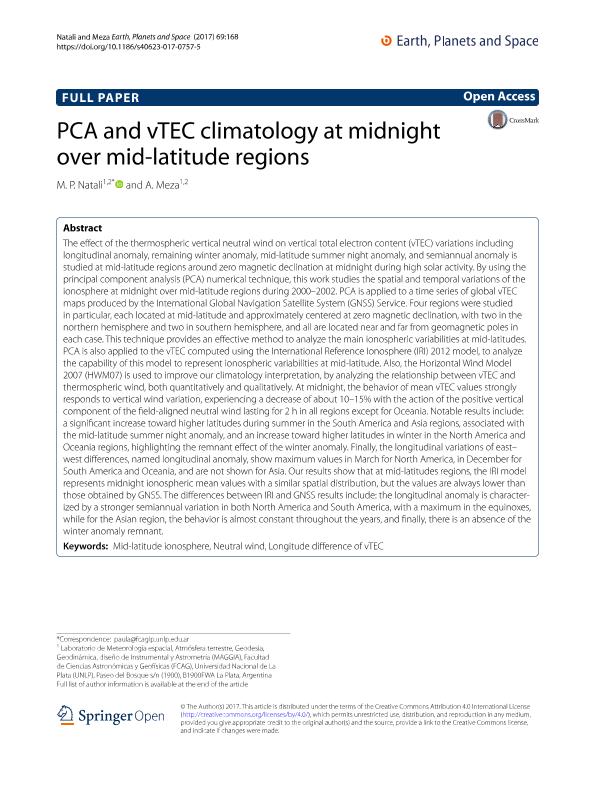Mostrar el registro sencillo del ítem
dc.contributor.author
Natali, Maria Paula

dc.contributor.author
Meza, Amalia Margarita

dc.date.available
2018-08-28T17:57:42Z
dc.date.issued
2017-12
dc.identifier.citation
Natali, Maria Paula; Meza, Amalia Margarita; PCA and vTEC climatology at midnight over mid-latitude regions; Springer; Earth Planets And Space; 69; 1; 12-2017; 1-22
dc.identifier.issn
1343-8832
dc.identifier.uri
http://hdl.handle.net/11336/57359
dc.description.abstract
The effect of the thermospheric vertical neutral wind on vertical total electron content (vTEC) variations including longitudinal anomaly, remaining winter anomaly, mid-latitude summer night anomaly, and semiannual anomaly is studied at mid-latitude regions around zero magnetic declination at midnight during high solar activity. By using the principal component analysis (PCA) numerical technique, this work studies the spatial and temporal variations of the ionosphere at midnight over mid-latitude regions during 2000–2002. PCA is applied to a time series of global vTEC maps produced by the International Global Navigation Satellite System (GNSS) Service. Four regions were studied in particular, each located at mid-latitude and approximately centered at zero magnetic declination, with two in the northern hemisphere and two in southern hemisphere, and all are located near and far from geomagnetic poles in each case. This technique provides an effective method to analyze the main ionospheric variabilities at mid-latitudes. PCA is also applied to the vTEC computed using the International Reference Ionosphere (IRI) 2012 model, to analyze the capability of this model to represent ionospheric variabilities at mid-latitude. Also, the Horizontal Wind Model 2007 (HWM07) is used to improve our climatology interpretation, by analyzing the relationship between vTEC and thermospheric wind, both quantitatively and qualitatively. At midnight, the behavior of mean vTEC values strongly responds to vertical wind variation, experiencing a decrease of about 10–15% with the action of the positive vertical component of the field-aligned neutral wind lasting for 2 h in all regions except for Oceania. Notable results include: a significant increase toward higher latitudes during summer in the South America and Asia regions, associated with the mid-latitude summer night anomaly, and an increase toward higher latitudes in winter in the North America and Oceania regions, highlighting the remnant effect of the winter anomaly. Finally, the longitudinal variations of east–west differences, named longitudinal anomaly, show maximum values in March for North America, in December for South America and Oceania, and are not shown for Asia. Our results show that at mid-latitudes regions, the IRI model represents midnight ionospheric mean values with a similar spatial distribution, but the values are always lower than those obtained by GNSS. The differences between IRI and GNSS results include: the longitudinal anomaly is characterized by a stronger semiannual variation in both North America and South America, with a maximum in the equinoxes, while for the Asian region, the behavior is almost constant throughout the years, and finally, there is an absence of the winter anomaly remnant.
dc.format
application/pdf
dc.language.iso
eng
dc.publisher
Springer

dc.rights
info:eu-repo/semantics/openAccess
dc.rights.uri
https://creativecommons.org/licenses/by-nc-sa/2.5/ar/
dc.subject
Longitude Difference of Vtec
dc.subject
Mid-Latitude Ionosphere
dc.subject
Neutral Wind
dc.subject.classification
Meteorología y Ciencias Atmosféricas

dc.subject.classification
Ciencias de la Tierra y relacionadas con el Medio Ambiente

dc.subject.classification
CIENCIAS NATURALES Y EXACTAS

dc.title
PCA and vTEC climatology at midnight over mid-latitude regions
dc.type
info:eu-repo/semantics/article
dc.type
info:ar-repo/semantics/artículo
dc.type
info:eu-repo/semantics/publishedVersion
dc.date.updated
2018-08-27T12:56:05Z
dc.journal.volume
69
dc.journal.number
1
dc.journal.pagination
1-22
dc.journal.pais
Alemania

dc.description.fil
Fil: Natali, Maria Paula. Universidad Nacional de La Plata. Facultad de Ciencias Astronómicas y Geofísicas; Argentina. Consejo Nacional de Investigaciones Científicas y Técnicas; Argentina
dc.description.fil
Fil: Meza, Amalia Margarita. Universidad Nacional de La Plata. Facultad de Ciencias Astronómicas y Geofísicas; Argentina. Consejo Nacional de Investigaciones Científicas y Técnicas; Argentina
dc.journal.title
Earth Planets And Space

dc.relation.alternativeid
info:eu-repo/semantics/altIdentifier/url/https://earth-planets-space.springeropen.com/articles/10.1186/s40623-017-0757-5
dc.relation.alternativeid
info:eu-repo/semantics/altIdentifier/doi/http://dx.doi.org/10.1186/s40623-017-0757-5
Archivos asociados
